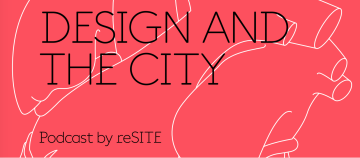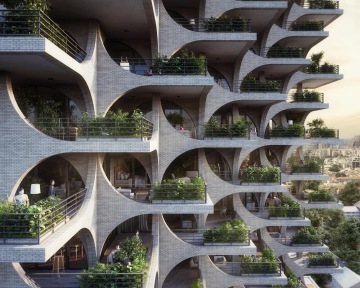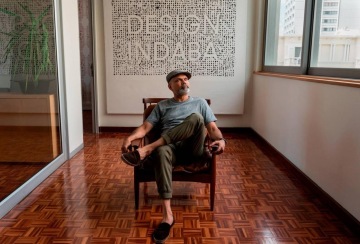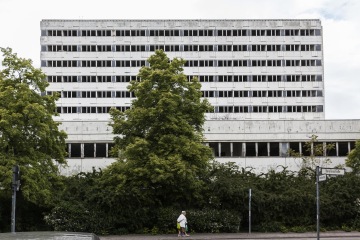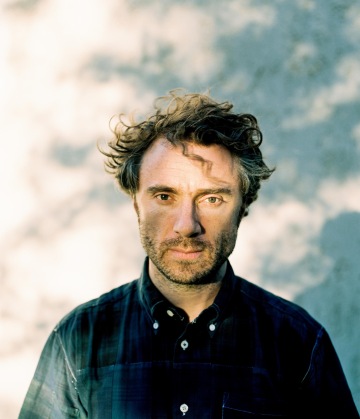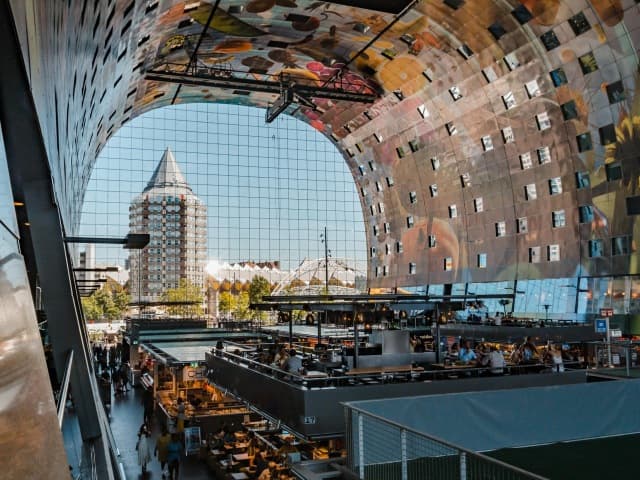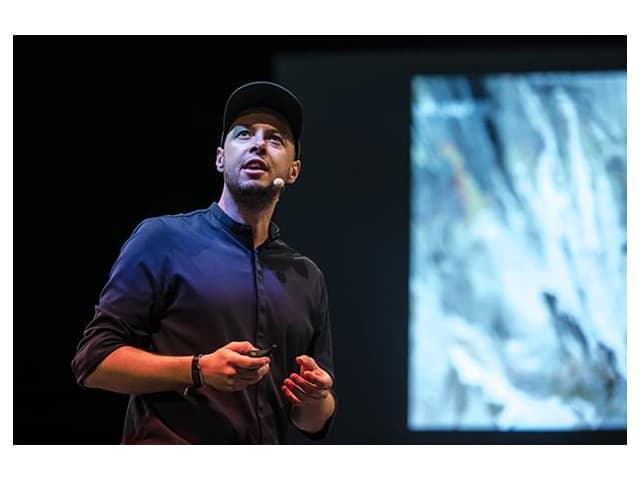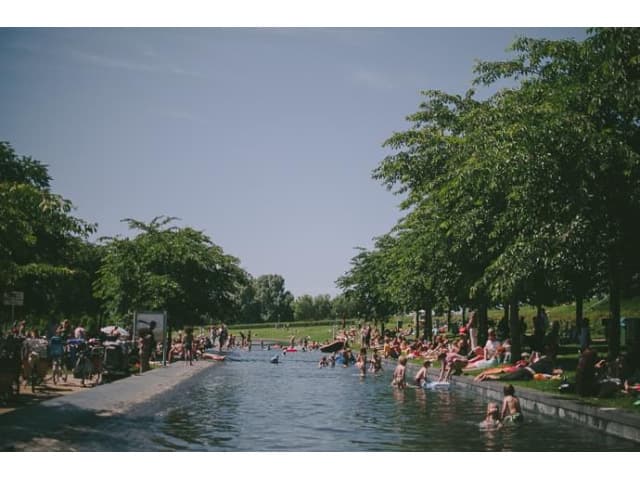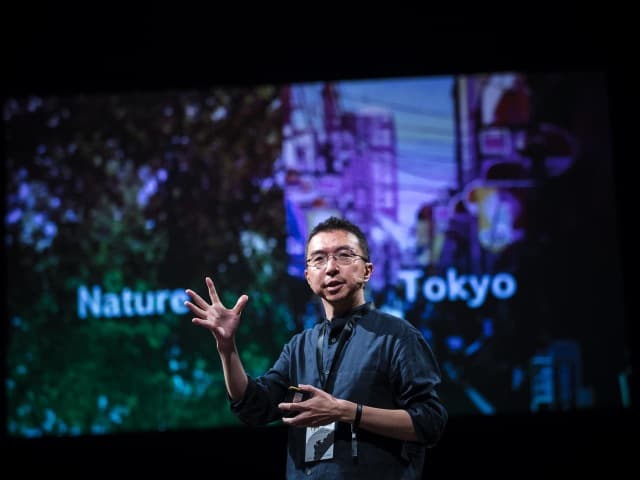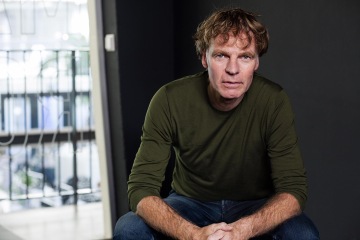
Winy Maas on Dipping Our Planet in Green
Design and the City is back with the first episode of our second season featuring co-founder of MVRDV, Winy Maas, in conversation with Martin Barry on greening our cities, his latest projects, and how constructive criticism leads to productivity. Listen now!
Listen to Winy Maas on Design and the City:
We spoke about his recent projects, including the retrofitted abandoned shopping mall close to the Taiwaneese city of Tainan. It’s part of a wider masterplan to rejuvenate the area that includes a circular food market, with a multipurpose roof, used for growing the produce that will be sold below.
He also spoke about the projects his think-tank, ‘The Why Factory,’ is involved in, the imaginative Green Dip that rethinks what a “green city” can look like, and the Manifesta 13 Biennale that took place this year in Marseille. He is energetic as he is inspiring. Martin was lucky enough to speak with Winy to discuss that question —what’s next?
Winy Maas, MVRDV + The Why Factory: Anyway, It's funny. Because I think the last trip that I made was with you, no, the last night..
Martin Barry for reSITE: To all our guests listening, of course, you, you know, Winy Maas is. The last time I saw Winy I think was on March 13, or 14th, somewhere around that time in Prague. He came into town and in usual fare, we exchanged some text messages, and Winy arrived from a meeting near the airport, I think, and came right for a late night spirit. We had a really nice conversation, which happened to be the last night the bars were open in Prague.
Winy: Yeah, I remember still, the day after I had a meeting and another meeting, and I really had to go to the airport as quickly as possible to get out of the Czech Republic.
Martin: At this moment, the both of us are traveling a lot. And of course, we’ve seen what was happening in Asia, the US. And here, of course, and seeing the media and getting like, you know, the half hug and we were sort of like, “Ah, this is probably not kosher anymore.” And then, of course, like now, our relationship with other people and the physicality we share with them is completely different since that night. So tell me Winy, what's up, in the last couple of months, I’d like honestly, to hear from you personally, like, if you learned something about yourself in the last few months. Everyone's telling me that they're living their best life, or they're trying to live their best life and be a better person in quarantine, so what's going on with you?
Winy: A lot of things, on one hand, of course, I'm not allowed to travel for my company. So that means also that I have to do everything from the Netherlands and or in the vicinity. And Zooming is, like you and others are all doing, everywhere. It has certain advantages, that's fair in terms of that I don't have to travel to all those places, at any moment. That's clear that it saves energy and time. There is also more acceptance for doing that, all over the planet, that I find also like a virtue that we gained, in that way, but say, after half a year, I miss a lot of people.
I miss also to simply exchange in the kind of coincidental manner more that cannot be replaced by social media. It doesn't affect, say in the short term, our business in the office; the upcoming year, it's full, one could say. If this would continue, like in the very long term, then we probably will lose clients because there will be more like relationships with local architects or local urbanists than needed.
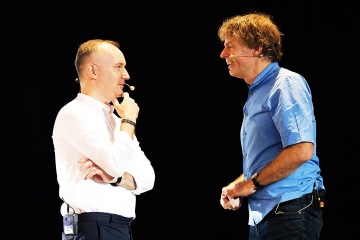
So what we did, in that way, what happened is that we immediately.. from say, that day in Prague, afterward, two days later.. we started to enlarge our satellites. So like, the Shenzhen one or the Shanghai one. We enlarged our appearance, in Taipei and in Seoul. We couldn't open our [satellite office], because we were too late for that, in New York, in that case. Actually a lot of things were closed. And we had to close our French [office] temporarily because of the complete drop-down of French building activities and we opened up a [new] Berlin one. So it's another way of working, therefore, things that you didn't dare to do before, namely, opening so many branches, that way you would take a good long time for discussion for you to do that.
Now, it's one of the things that you need to do, in order to avoid traveling and to still have a local presence, or say presence within that color in the stoplight system or traffic light system, of acceptances over the planet. And I think that's also nice, because that is also good that you create more and a different people are now already in the first row, to say, which is also fair, that you have to listen, maybe even more carefully, to other people in these kinds of satellites, because otherwise you do it a little bit by your own interpretation and you have a meeting. So it is not faster, but it is another way of dealing with it, so that's on the business side.
I would like to say I'm happy, in these days, because some markets dropped, like the French one—in a way, but the Chinese market grew and the Taiwanese market grew and the market in Korea grew so that compensated for, obviously, our activities. But having said that, I think also that the competition became stronger, between, say, if you call it a “Champions League” or between many offices, the list of offices that you know. This has been tougher, and interesting, so we are analyzing that also from our side.
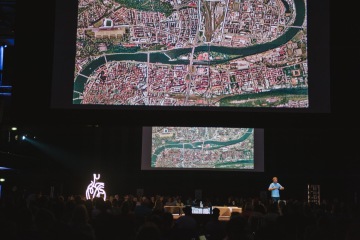
Martin: And personally, I'll ask more about the projects in a second, but what are you doing? Reading more? Are you getting more sleep? Are you eating healthier? Or the opposite? I mean, I also found people working three, four hours a day more because they sort of gain back time from traveling or being on a train or whatever so, how’s it been personally for you?
Winy: That’s um, let’s see yes, sports, I do more sports, to be honest, but that’s replaced running for a plane. So that's the run now more in the countryside or in the city. So that’s true, although I did that before, already. So that has not changed so much. I think working, because we couldn't even work at the office for a while, so I replaced it [with my workplace at home]. Yeah, where what is then your home, you can be. I have a house in Rotterdam, and I do [work] from there, but I can also replace the house with an apartment in Paris, or buy a house in the mountains, and do everything from there.
So I described that as a kind of continuous state of “artists in residence,” that is how I felt for the last six months. It is also nice, because at any weird moment you can swim, or you can run, or hike, and Zoom in between, so it's another rhythm, for sure, in that way, and for a time it’s also pleasant, I think because everyone has this aspect, and I'm not touched by this disease; my relatives and friends are not touched by it, which is, of course, an enormous, fantastic point in that way.
Yeah, I also know people that have [been] touched severely by that, and for them, this is not a nice time. So they will speak differently, and for them, I am, in this kind of mode, and maybe also as the boss of a company, [I must] behave in a responsible manner. So to keep distance, and to say that to people and to do that in the office, now we're 40% in the office, I would say.. but also to students, and also on the street, or on the terraces. That is what I still take seriously, because I don't want to [make] a contribution to those who suffer, and not go back to that situation.
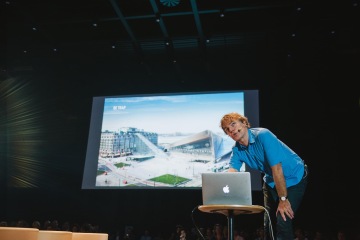
Martin: Yeah, I think like for people like me, and certainly you, the physicality of our experiences, and the coincidence that you mentioned before, it's obviously like, it sort of puts a hole in us, I think, emotionally intermediate. And particularly when we were in the biggest part of the lockdown in the Czech Republic, I found myself you know, walking to the office, even though it was empty, just because, first of all, I like to kind of be in the mothership, when we were under so much pressure, but also just needed to kind of feel the city around me. And it was really important for me to have that experience every day to have some resemblance of normalcy. So I really kind of feel that a lot of people probably feel this way in the city. So many of your projects are about coincidence. I think like the last time we spoke..
I love life, and I love people, and I love cities that are alive.
Winy: Before that we go into that, Martin, just to finish it off, I think because we all felt in those days that we were like walking in the most real painting of Chirico, in that way, we're surrounded by emptiness and by nothing, where every building becomes basically a stage set, in a spooky stage set. I find it devastating. I think even it could give me some calmness or some reflection, but the purest reflection is that I love life, and I love people, and I love cities that are alive. And I'm not sure if I’ll like Chirico ever again, from this moment on; I’ve banned his paintings from my house. Because somehow, I do hope that in a year from now, we cannot be hedonistic, and don't say yes, learning from this period is encouraging green and encouraging sports and encouraging parks, but in a kind of vivid way, that is for sure what I hope to see soon.
Martin: Yeah, there is this kind of desolation, at least where I live, and I live directly in the center of the city, I think you know where I live. And this is a part of the city which is mostly frequented by tourists- when they're here, now they’re not, and haven't been for a few months. At kind of the height of this pandemic, it was really just, sort of, me and the dog and some stuff going on, around on the street, and empty shops and then occasionally you see, you know, one of the drunk guys that are living on the street nearby. And that was sort of it, so at that time, I even encouraged my wife not to walk the dog at night, so it was great for her, because I'm now the dog walker in the family. But yeah, desolation really puts a hole in me. I really feel like I'm such a social animal, that I really need this spirit around me that it's hard to replace.
Winy: True.
Related: Why Dreaming About our Future Cities is Essential with Winy Maas
To bring this full circle, Winy spoke at reSITE in 2017, presenting his idea behind the stairs—a seemingly simple intervention with a massive impact.
Martin: So, what I think, the last time we spoke, you talked about Rotterdam, “Stairs to Kriterion,” is the original name. And I was kind of shocked that this is becoming a real project - is that still happening? Because talk about coincidence in the city, this is one of my favorite coincidences in Rotterdam. What's happening with that project now?
Winy: No, this is not happening yet; the owner of the building [changed] and the idea is loved by people. In order to activate the idea.. and the plan was to have in mid-May, during the Eurovision contest finals, to have a couple of stairs in Rotterdam, and not only stairs but also bridges. We had the finances, we had all the approvals, we had [it] all, so it was fantastic to, say, have a moment that you could walk from roof to roof like if you were in Gotham City, and then be connected to many destinations in the city center. What you could do, from this roof and from this roof box, you could basically celebrate the city and that was also the place-- intended to be the place- where the winner of the Eurovision contest would sing, and where we would party and where we would be together.
So it's a bit of a pity, you know, everybody has this kind of story, what didn't happen during COVID, and this is one of them. That's connected to your, to your question. So that came to, I hope, a kind of temporary standstill, the Rotterdam finals will take place in a year if that is possible, and then the project could restart. That would also help them to try to make permanent connections on the Groot Handelsgebouw, as it's called, and in the district that is surrounding it.
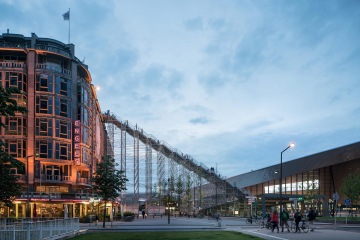
So I didn't find it, in Rotterdam, yet, a fixed situation or permanent situation [for the project to call home]. But there’s other good news: that is, that Germany [operation] continues, and that I'm happy that, in the end, like in the center of our Manheim extension, the Benjamin Franklin city, there in the center, these stairs are appearing in some of the high rises that we are building over there.
We’re [making] four high rises, as an urbanist, which form four letters, H-O-M-E, “home.” That celebrates, therefore, this collective “home finding” of the world, where the holes of these letters are then connected by the stairs towards the central space, that celebrates, then, this combination. So the stairs are high, they're the same height as the ones in Rotterdam. So that makes, hopefully, a beautiful backdrop of that plaza, and that, we’ll start construction; the first one we’ll start construction, in exactly a year from now. So that's, anyway, another place where that can occur, is an attempt to three-dimensionalize our public space.
Martin: I love this, about this project, and other projects that you do.. you sort of test the idea, you let it live, and you try to push it as far into the future as possible, when successful. So this one sounds like it's going to live on, in another project, particularly in Mannheim. That's really cool.
I think, a technique that can be used by so many architects and urbanists these days, now, to use this kind of temporary installations.
Winy: I think the idea, what you say, to use temporary projects, like the Rotterdam Stairs for five or six weeks, and then test it out also in terms of popularity and usage. That is useful, to bring it to, say, more permanent awareness and permanent potential. I learned that also, from the stairs, and that is, I think, a technique that can be used by so many architects and urbanists these days, now, to use this kind of temporary installations, almost art installations.

Speaking of installations, MVRDV along with Maas’s think-tank, The Why Factory, played a central role in this year's European Nomadic Biennial, Manifesta 13, which took place in Marseille, France. They led a pre-biennial interdisciplinary urban study focused on the southern French city, named “Le Grand Puzzle''.
As Winy put it, the publication shows the urban possibilities and impossibilities of Marseille, through conversations, analyses, maps and ideas - a "manifesto" for the city - serving as a platform to develop artistic and cultural interventions during the biennial in 2020.
Winy: Well we tried to do that, by the way, Martin. Also, in another COVID-touched event, in the Manifesta in Marseille which opened, as one of the only biennales, last weekend, where we basically made an inventory of what the city would need. Because these things, these temporary installations, as done by an artist, or done by an architect or done by a collective, or done by an NGO, are actually the best way to make a biennale, I would say. And they are connected with agendas, where the stairs in Rotterdam are connected by the concept of intensification, and use rules for that, in a way. In the biennale, in Marseille, we could develop like a theory, the book just came out, of how to make an agenda for Marseille, and what kind of interventions.. could test out some new policies and therefore, directions, longer-term directions, that could lead to an impact [on] urbanism, I would say.
And the list of Marseille, there's thousands of ideas, done by many people. So continuing, made not only by students, but also by different NGOs; these kinds of bottom-up ideas, that touch on these greater agendas, that are visible. Not all are built, because that was impossible in COVID times, but the book is there and the ideas are there.
You have to know that Marseille is a huge puzzle.
And the new mayor is [involved] with one of the projects, that we talk with many people in the city of Marseille. You have to know that Marseille is a huge puzzle. It's “the place,” [with] the maximum amount of NGOs, much more than in Prague, or in Amsterdam. [It] is very active, with 111 mini-municipalities in it, that is continuing now, to honor the theory of the David Freiberger, which is, I think, a genius in the world on theorizing bottom-up governance, as such, and is used also by Macron in his ideas for the climate change projects. That is then applied on an urban level.
I was very happy that we could do that, and have some of the exhibitions, have the book, have this starting process, have this collection of, of togetherness. Even under COVID times, [to have] a kind of working method for developing citizens, using prototypes and strong, visual prototypes, also done by artists, done by certain architects that can do that— not all of them are very conceptual—but that helps. That’s strength, in there; so please read the book, and see the ideas of how you can do that. I'm looking forward to the next step in that process in Marseille, to a post-COVID biennale, or other biennales, to test that even more, that it would be so active.
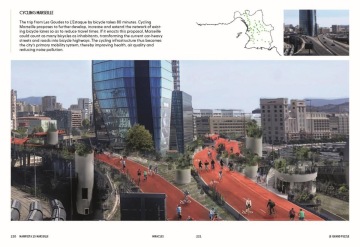
Martin: You describe this context of this biennale as an archipelago of European cities, and this is kind of an archipelago of ideas. I like this, that the architect, urbanist, or urban planner becomes a kind of choreographer of ideas for a city. This is a really strong point, and ideas [through which] you can test the psychology of people, you can test the economics, when they're done on a small scale. I like this temporal nature.
Winy: Yeah, sometimes it’s a painting, sometimes it's a photograph or an enlarged photograph, and sometimes it's a kind of decomposition. In Marseille, for instance we made an app of all the graffiti and, I mean, the whole city of Marseille is basically a canvas, and it has the biggest amount of graffiti in the world, even more than in Detroit.
But if you facilitate that, and see it as an advanced way of communication, and tolerate and even choreograph new paintings over it, new descriptions over it and categorize that in itself. So, that was one of the projects, how to mobilize, basically, in a different way, with limited budgets, but to stage art and interventions. Yeah, it's a pity that you cannot go there now because of COVID, and it's a pity that not everything succeeded.. but the idea was there.
Martin: It’s a way in which you even say, “deepening our textual analysis,” right, and you described it in Copy Paste, that in 2017, in the book, readers, and listeners out there familiar with that book, and is this like this kind of a new way to test people's innovation or innovative ideas for cities, what you're doing in Marseille, does it relate to the idea that you develop in Copy Paste?
Winy: That's not completely Copy Paste related. In this case, it might be a confusion; the book, Copy/Paste, was a little bit about innovation, but to give also space for deepening the knowledge of what has been done before, so to accept it. I like what Rem has done in certain buildings, and I tried to deepen it in certain cases, and that has far more people, and there was a taboo on that. And we theorize that I think in Copy Paste, as a kind of sequence of evolution.
Some of the ideas in Marseille, of the students or of artists, were so strong that even if not [yet] built, they became instrumental for urban planning,
The technique of Marseille, say, the past portoro technique, which I will say is different, and I will describe that later in the book. That is, that is not only Copy Paste, it's like showing that a strong piece can speak out for bigger agendas, like the stairs did, but like some of the ideas in Marseille, of the students or of artists, were so strong that even if not [yet] built, they [already] became instrumental, as such, for urban planning, and activated anonymous reactions in the population.
The government of Marseille, in the preparation, I got in trouble [twice] with a local newspaper, and with local politicians at that moment, because it was a bit contrary to their working methods and to their policy, and they were afraid.. that [these] kinds of installations would harm their election in the coming term, which actually happened, because now there's a new kind of government, and it was very intriguing-- super green, super bottom-up oriented with a great group of elders. So, somehow, it helped on that level also.
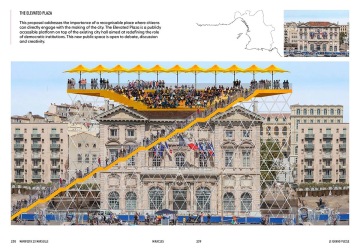
Martin: You know, this podcast is for reSITE, and the first year that I launched reSITE, we had a competition. The competition was about reenvisioning the waterfront in the city of Prague to the riverfront of the Vltava, and there hadn't been such a competition to look at the scale of the city, like that. And initially, the government municipality loved the idea of creating a design competition for the riverfront, but after like one month of them actually seeing the design briefs, and [realizing] that we were going to be collecting hundreds of ideas, that they then would have to act on, the project suddenly became politically potent. And so you know, very soon after, the government-backed away from supporting this competition.
Winy: Well, I know Martin, but maybe now you have more freedom. So that reSITE 2.0 can use that freedom to just propose things, that you can read in the Manifesto, that has been made, that there is an incredible liberty by proposing and by making that, [by moving] very strongly forward and quickly through. I think, even in the name, reSITE is actually about that. So I think that your next “re-site,” even if it's not completely financed, maybe, in the same way, can be like this kind of virtual proposal. The sequence of proposals that could be done there, and that could be imagined to be made by NGOs, or by smaller groups, that manifest at the moment, [could] change, in this case, Prague. If we make a beautiful new virtual model, then and put that in to illustrate that; that would be wonderful. I'm happy to help with that new map of Prague. This complete rePrague as you can see it, [you can] skip the competition of the river, and just do it yourself.
Martin: Yeah, we can; we actually did that competition in the first year of reSITE, back in 2012. And we had 723 entrants, and 175 ideas came forward, and it was a really fun process, but without the support of the government. I think that's a great way to kind of kick people into action, to say, you know, “We have these resources, we've got these aspects of the city that need improvement,” and that was the most fun part of the process. Maybe now reSITE’s job is to make our own proposals for the city. That certainly could be, just like in Manifesto.
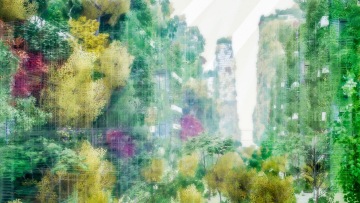
The Why Factory’s Green Dip digitally reimagines metropolises, like New York and Hong Kong, and rethinks the typical set “green space”, merging it with the existing urban fabric and transforming concrete jungles into green ones. Think: skyscrapers completely covered in plant life, a site that transforms the skyline into a living urban canopy.
Martin: Oh, I think one of the most interesting things I've heard lately is when you talk about the Green Dip. I heard you recently talk about “dipping the planet in green, much like we would dip our ice cream and chocolate.” So many of your projects lately have been kind of draped in green and sort of emanating this kind of sustainability spirit. And I think one particular project, or maybe two, in Taiwan, I'll get to that next, but what's the deal behind the Green Dip?
Winy: I was intrigued by many comments that I got, by critiques, that you cannot put trees on top of buildings. Or a while ago, when we started with Hannover in 2010, with the Dutch pavilion; I was amazed by the beauty of Stefano Boeri’s building in Milano, and other places, and he is part of that campaign. And I thought we should radicalize that by making, basically, a software, to start with, where all products of green could be made for facades, streets, balconies, and, and roofs, to study the angles and the effectivity of that, and make these inventory of techniques and technologies and then see how effective they are in terms of what they give, how much oxygen they give, how much co2 absorption they give, how much ventilation they cause, how much cooling they can do, and how [many] birds they can create nests for, in that way.
We have to maintain our lives, and our planet—how much water it costs, or how much it can store, how much “Earth” it costs, and how much structure it costs, etc.
So we made this, so that's one, and on the other hand [to calculate] how much it costs. Critics say it costs a lot, in maintenance, which is true. But anyway, we have to maintain our lives, and our planet, how much water it costs, or how much it can store, how much “Earth” it costs, and how much structure it costs, etc, so we made that script in the Why Factory, like a year ago.
And then secondly, we started to apply it all over, first all of our cities, and [we’ve] made films about it that are on the internet, and some of them are gorgeous, according to me, like walking on Fifth Avenue in New York, and then being completely surrounded by forest. I think that replaces the Chirico experience of the last time even in a sublime way. And also all the cactuses in Dubai, and the dates [palm trees] cover some of these ugly buildings there. So, there is a beautiful film.
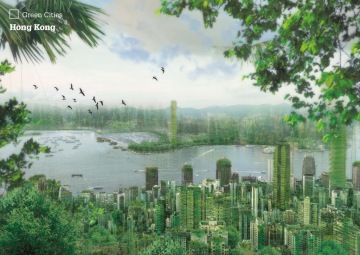
And third, we then developed the effect on the planet how, how much that would lead [to], if we would do that in a proper way. One of the conclusions is that, it would contribute, if we recover all our cities, which are about 3% of our planet, so not too much, then we still.. because of the density of doing it, because to be in the very heart of the of where people “spill,” basically where they consume much water and energy.. it would give already a drop of, in total, 1-1.2 degrees Celsius over the planet. Which I find significant in the help of climate change, besides all the other effects that were there.
So this book will come out soon and describe that software, [which] will then be available, as part of that book. And the films will be accessible and three-dimensionalized even more and lead hopefully to a kind of image. And it is, of course, shared with those that are already working on it. And it's not only MVRDV, as well as, I mean.. as I said also, Stefano was working hard on this, and there are a lot of other architects working on covering it with green ..but this supports this disconnected group of people, with a kind of theoretical and applicable “Bible.” That is what I can contribute to this “green-ification” of the world.
I'm happy that I can do it also in our work, and it's correct that you see that, as we speak, happening; it’s a launch of projects under construction and just having won, all over, in that way. Two of them are somewhat recognizable as they are under construction, three, I think. The Depot in Rotterdam, and we just planted this forest and we are testing these effects on its height, and we’re gaining knowledge about wind protection and windshields that are built in this building. There's a pre-opening of the building next week, but the real opening is in a year from now.
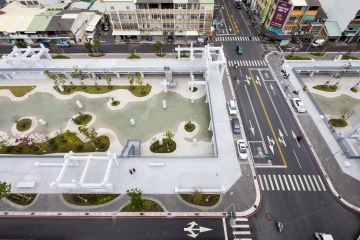
That is the one test ground; the second test ground is the Valley, in Amsterdam, a three-dimensional mixed-use tower landscape in the Zuidas, and where the scripting that we are part of, is connected to the grid, in-depth, has made it possible, feasible, buildable. To have it combined with our building logics with light and with building technologies like steel or concrete paneling; now you can see the contours already, it's like 80 or 90 meters high. It will also be opened in a year from now. We’ve built out from there, and we developed on that base, the water system, the maintenance system, and the planting system of these towers. So that's another technique than, say, the vertical planting, as another technique than balconies, it’s basically interconnected terraces with stairs and water loops that make this 120-meter figure applicable.
And the third one, of this Green Dip experience, I think, is our Market Hall is in Tainan, a city in the southern part of Taiwan, where we just have done this pool, which was a test on climatic cooling. And within the same city, we made this open market with a roof on top of it. The market is for vendors, say, for farmers that sell fruits and vegetables, so not [selling] fish or meat, and the products will also be shown and planted on the roof, as a collective of these 500 farmers that are there.. to make this collective farm where you can eat the products, more permanently, and sell them downstairs.
I would say that 2020 will be the year of the Green Dip. To have that green space; public spaces need to be made, not only for keeping distance, but also for trying to use “green,” for better food, to have a test on what green [methods] could help against diseases.
[There’s also] this landscape on top of the roof; it’s a one-hectare building with this undulation, with its terraces, with its water systems, with a restaurant where you can eat that food. I think that is also one application of that Green Dip, and deepening the knowledge about that, in this case, the food products that are also part of that Green Dip. So I'm very happy to make, as we speak, this very combination.
So, I would say that 2020 will be the year of the Green Dip. Coinciding with COVID-19, which is also a plea, to have that green space; public spaces need to be made, not only for social gathering and for keeping [social] distance, but also for compensation in the end, also for trying to use “green,” also for better food.. not sure if we should eat meat. And that's also what COVID is [teaching] us, to have a test on what green [methods] could help against diseases.
So the first test, in terms of malaria with mosquitoes and green is done. And basically, at the University of Barcelona, there is a beautiful test also on dengue [fever]. That's done in Taiwan, also using some of this knowledge from the Tainan pools, which, for instance, now have lower water because of dengue threats, and to see how it can react to that. But it also needs to be done [to look] into virus distribution or ventilation of the city. That research has not been done yet, very deeply. And so your question is, therefore, also for me, like a yell at universities, who will start to do this kind of research, which is then what we can learn from COVID.
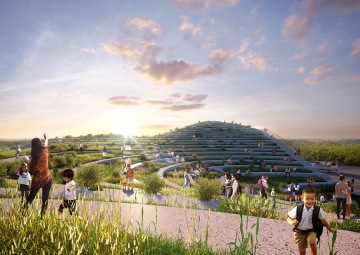
Martin: Yeah, you know, I have to talk more about Taiwan, because if I don't my wife will kill me. All of our friends in Taipei and Tainan will want to ask more questions.. For the building in Tainan, and first of all, I'm also in the market business, right-- we have markets as well, not fresh fruit markets like those designed in Tainan, but we understand the context really well. So, when you told me a few months ago that you've got to look at food markets, because you have typologies to study, I loved that, because the market itself is relatively antiquated the things that happen in markets, or vibrancy, are totally essential for cities but they haven't really been rethought in a long time. So, when I saw this project, and particularly in a place that I also love, Taiwan, I want you to know, I was just enamoured with it. The idea of 8000-- is it really 8000m²?
Winy: In total there will be, in the end, 10,000 m², because there is also an extension going on, as a starting point. So, it is also a concept that can continue, if there's a new mayor [who] wants to extend it, so we are also faced, unexpectedly, even before it's finished, by a continuation, which is nice.
Martin: And what happens on the roof? Is it a public park or a place to grow crops?
Winy: It’s basically a farm, and it’s constructed out of terraces that follow the contour lines, and every terrace holds another species, that will be planted in, and that’s managed by the cooperative of the market people, in cooperation with the agricultural department of Tainan. They aim to test species, on artificial grounds; they aim to test cohabitation of species, because many of the species grown in the Tainan region are monopolized, very monotonous (monoculture crops). Ananas, or pineapple, are planted in huge monoculture areas, and bananas in the same way. So, it might be beneficial to plant in mixed circumstances, which will be happening on that roof. Then, of course, they want to attract people to stay longer in the market, so to go up on the roof, to pick fruits or to have dinner, in the collective restaurant.
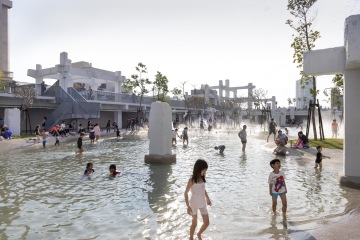
Martin: That’s a really neat project, and you’ve done a lot of work in Tainan, so you’re working mostly for, and with, the city, I suppose. You did Tainan Spring, this project is open now; I think you came back from that in February, is that right?
Winy: Yeah, I basically flew from Tainan to Prague, after being there for the opening, which I enjoyed a lot. Well, the project is an abandoned mall, a Chinese department store; we turned that into a park, while keeping the ruins of it. [It was] a very complex project, by the way, because it’s in the former part of the sea, so the pressure of water below is enormous. So, when you kill a building of ten stories or, in this case, twenty stories, then you immediately have to put [down] the same weight. You have to keep the same weight, because of the pressure below. So, we used the debris and parts of the structure, to compensate for this pressure below, and the water [that we put in] also added some weight to that.
You can swim [there] in a ruin, and as one part of the study, because of the enormous heat in the southern part of Taiwan, and in Tainan especially, it’s so warm because they lack plantations in the city; it’s super stone [environment]. The combination of the water, in this beach construction that we made on the bottom of this ruin, is combined with fog and with vegetation, which keeps the cooling [effect] coming from the water and the fog.
It has become, not only a physically cool place, but also a psychologically cool place. A place where you cheer up, where architecture somehow makes sense, and it has become an instrument.
It has turned into a tremendous usage in these five months; you can just look [it up] on the internet how kids and people are looking at it and how they stay there. Now they finally have a place, in a hot climate, where they want to stay and where it’s so cool, in physical terms, that they want to hang out. It’s a free place [where people] can have picnics, have tea, and swim in the water. I’m very proud of the technology we used for the concrete-like pebble beach; it’s so soft that you can walk with [bare] feet, in a public space. You can see children now, playing in it, and the fathers and mothers are also going to swim in it, which is a cultural change. You know the place a little but, and Asia is not like Denmark, where you jump into a pool in your swimming gear. Cultural habits are different, in that way, but now it has gradually turned into that.
So it has become, not only a physically cool place, but also a psychologically cool place, and I’m very happy about that. It’s really a place where you cheer up, where architecture somehow makes sense, and it has become an instrument which we can now apply in more places, like you say in the Green Dip, or in the Stairs, you can test something which can be applied more.
In this case, the cooling “machine” we proposed for a site in Germany, [we want] to extend the knowledge of urban cooling with vegetation, ventilation, water systems, and materials, [using them] in a systematic way. I hope to show that soon, that [this] instrument can be extended and systemized, can be converted into a systematic laboratory to test what species will help with cooling, what combination of materials, say, concrete or terracotta, with certain species, and how much fog I’ll need.. So this kind of sequence of channels, kind of a ventilation system, like you normally use in your house that [can be] applied in a three-dimensional manner in this proposal; that will come out soon.
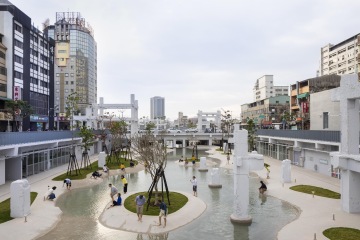
Martin: Yeah, you’ve changed a shopping mall basement into a swimming pool port in the city, and I want to relate to, a bit, what we’re going through now. We’re seeing in cities like New York, my hometown, people are saying everyday on social media or in the papers that “New York is gone, it’ll never come back.” You know, that people have left the city for the suburbs again, or the countryside, and while I don’t think that’s totally going to be a long-term trend.
I think what it’s exposed is that we haven’t really built a city for ourselves, for the future, a place where we really want to live.
I think what it’s exposed is that we haven’t really built a city for ourselves, for the future, a place where we really want to live. Places like this, in Tainan, kind of, provide a respite, a place to relax, dip your feet in, be with your parents, in the center of the city. They give you space to breathe and give the city space to breathe, which I think, places like New York have struggled to do, though we’ve made huge progress since the 90s on this. It’s still not the place where people maybe want to stay and live, so this moment has given us the chance to restart that process, and to restart the way we think about public spaces. Turning shopping malls into swimming pools, I think, is a good way to start it.
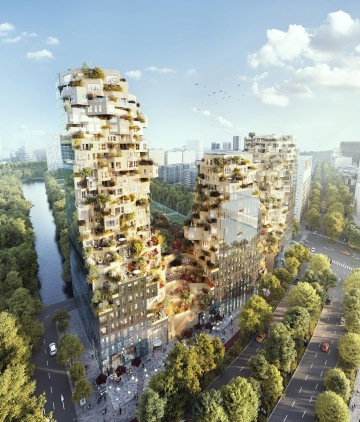
Winy: With the current usage of shops, I think this is easy to apply in many places. So you can take the idea further, in your work also; so please, do it.
Martin: We will, and there’s one more thing I want to talk about, because there’s obviously criticism on these projects, right? One of them is, you had a proposal for Gazpro-- the idea to make a sustainable headquarters for a gas giant.. or even [the idea of] putting swimming pools in derelict shopping malls, comes with a certain level of criticism.. how do you deal with that as an architect?
I think it’s a pity that we don’t use our collective power to make the planet better.
Winy: Yeah, I think that’s almost one of the key elements in anybody’s life, [to learn] how to make constructive criticism, and to see evolution of your work, of the world, of the planet, of the city, in any job you [have]. Innovation is needed to catch up with the speed of the decay of the planet. So, that counts for everybody. For me, personally, yes, I don’t want to refrain from that.. There are lots of architects who do that; not all of them do that. There are also many offices that are so corporate, that are so connected with the service industry, and are so afraid of their jobs, that they refrain from that critical component or that they leave a very limited amount of space.
I can understand that, but I think it’s a pity that we don’t use our collective power to make the planet better. That’s a very edgy activity, because you surpass vulnerable zones, especially in certain countries, I would say. It’s easier to speak out in Denmark or in the Netherlands than it is in places which have a really strong, less democratic character, and where these kinds of voices can easily be put into prison, or be poisoned. People are afraid of that, I understand.
I hope that our work can somehow do that, because I do believe that we need a world where, in the end, frontiers are open, where there’s complete and beautiful freedom, liberty, and democracy.
Sometimes you come into circumstances [in which] you can make a difference. I hope that our work can somehow do that, because I do believe that we need a world where, in the end, frontiers are open, where there’s complete and beautiful freedom, liberty, and democracy, so we hope to contribute to those elements. You can hear from me, when we get projects, that we try to discuss that, internally, what can we achieve. Some people say you should refuse to work on certain commissions. I’m not personally in the position that my refusal will say something. I think if you are on the level of presidency, of a bigger country, then you could do that. I think Merkel is showing that, in her way, and Trump, in another way.
As an architect, sometimes it’s better to work on it, and try to make a difference, and to enlarge that, as such. I think some of our designs in Asia show that we try to achieve a certain kind of liberty in our planning, liberty that didn’t exist under [previous] circumstances, and to deal with that. I think the Tainan pool is also edgy, in those terms, because you get the question in such a culture, “why do you plead for nudity?,” which is not culturally acceptable. And I don’t plead for nudity, but for cooling, and maybe, in the end, for an update of our [openness, because] nudity is a symbol of our openness. When you’re naked, then you have nothing to lose, so maybe that’s quite symbolic, actually, now that I think about it. So, [we are] somehow trying to raise that point; it’s very political, but I know that urbanism is, by definition, political.
As you talk about the city, in that way, [you see that] architecture facilitates urbanism; we facilitate, therefore, politics of cities and of countries.
As you talk about the city, in that way, [you see that] architecture facilitates urbanism; we facilitate, therefore, politics of cities and of countries. You do what you have to do to gain that, sort of, perspective in the longer term; so, some of these projects are about that. That’s very true, I think, the Gazpro proposal, and also collaboration, because it’s a proposal but also with many stages of competition, where we collaborate also with the staff of Gazpro to imagine what the future can be.
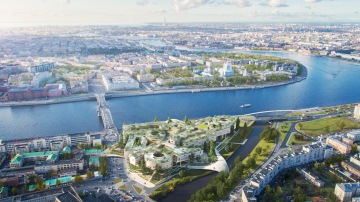
This building Winy is referring to would have been the world’s largest timber building and a CO2 storage deposit that would not consume any fossil energy. The proposal came for oil giant Gazprom Neft's headquarters in St Petersburg. MVRDV entered the competition as Winy put it "after considerable debate" and internal discussions over the merits of working for a client that is a heavy polluter, ultimately deciding to uphold their dedication to sustainable design.
In this case, with their headquarters, we decided to enter this collaboration by proposing a headquarters that could be, in and of itself, a different way of thinking about energy. By using a completely covered solar system, which is a very beautiful system, by the way, it is equipped completely for the north. It’s easier to do it, maybe, in the desert, but how can you also do that in northern countries? It’s well-developed. We compared that also to the “green-washing” component, which can be negative. On the other hand, also, if you do it publicly, and calculate what can be done, it can enlarge your perspective as an energy-providing company. You also see that happening in other places now, like Total or BP, who are already dealing with windmills and PV cells.
With a project like this, there comes criticism which can lead to productivity and to small changes. This is what architects could do; that’s what these projects show.
So, preparing for the future market is also shown in this project, and [we] discussed it with them while working on it. To deal with a fully wooden structure, was also an aspect of that-- to avoid concrete, which is basically a monster, in terms of CO₂ production-- to reduce that, was part of the design.. to make that doable and to immediately [plant] new forests . The good thing is, they own [a lot of] ground and reforesting that was part of this plan.
Last but not least, the building is on top of a very historical place in St. Petersburg. So we didn’t want to touch, say, the graves of the past. So, the building is floating; it’s lifted [up] about 18 meters and in [the space] between we planted birch trees and pine trees, between the ruins of the past [and the new building]. We basically made the biggest tree hut in the world, and that gives us a sheltered climate, against winds and snow, and more permanently, trees can still produce sufficient energy and heat in the winter. This combination, this three-fold enterprise is what we celebrate.
At first, they chose a different winner [of the tender] but it’s nice to see that due to COVID, there’s a discussion and reevaluation going on, of what would be best for the company, internally, and also for the city, with this project. So, that’s nice to see, that this committee takes time to reevaluate the value and worth of this enterprise. With a project like this, there comes criticism which can lead to productivity and to small changes. This is what architects could do; that’s what these projects show.
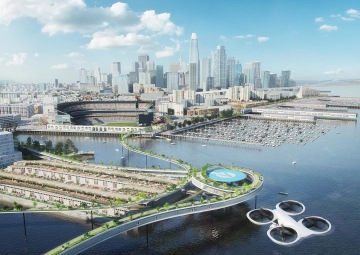
Martin: Yeah, that’s obviously a provocation, and I shouldn’t say silent.. because the act of doing such a building has quite a massive impact on people’s psychology and how they view a company, how they view the city, so I think it’s not such a silent provocation, but you’re using architecture to provoke us to think a little harder about how we build.
We should encourage all architects to do this, and I am happy to hear there is a reevaluation by the committee; that’s great to know. We, personally, like the building. I like the building; what you don’t talk about is the psychological effect of timber. I love to be in a building which has a lot of wood, because it has a sort of calming effect. I, personally, hate cabins, but I do like wood in the city, because it’s very soft, and the way in which you feel in the city. I like that a lot, particularly in a place where you work.
Winy: Well, the interior perspectives show that, and I think that the HR department of the company appreciated that very, very, very much. Also, when they checked with all the employees, they have the same feeling as you. It's not a cabin, but it’s a super soft environment that you create, and a very human friendly, healthier environment. It's clear that a wooden office working environment breathes-- it’s more ventilated, it has fluctuations in humidity-- and those are aspects that help our health, especially when you have to stay over 10 hours a day in an environment. This was part of their observation, and their reasoning to go along with our proposal.
It's clear that a wooden office working environment breathes—it’s more ventilated, it has fluctuations in humidity—and those are aspects that help our health, especially when you have to stay over 10 hours a day in an environment.
Just a word about provocation, because provocation is a word that is very different in many languages and many cultures.What you mean is basically that provocation is a good thing, is positive. There are societies that see provocation as very negative and very biting and very dangerous, as such, so we have to find a culture where provocation is a help towards the future. To make it very explicit, to enlarge it, to have this kind of momentum that you can see it and understand it, which causes not only a ‘wow’ factor but a shock factor, that is what you can do sometimes. Then the provocative touch will get this kind of double meaning, as I just discussed, as a negative or positive, but the shock issue creates an awareness and discussion. That's what this is aiming for. I’d like to deepen your wording for the listeners to understand this duality.
Martin: No, it is really important to understand the difference in the way that society, in which we, can approach provocation. That’s a really nice addition to what I said. Thanks for clarifying it for every listener. We’ve been talking for almost an hour and I expect you have other things to do.
Winy: Hahaha, you have a very American way of saying “let’s stop it.”
Martin: No, I'd speak for another two hours if I could. But really I think your time is valuable, sir. So let me ask you in this way, and maybe it’s also an American way of saying it, but is there something else you’d like to add?
Winy: No, I mean I appreciate this conversation. Maybe I talked too much and I talked too long, but that is the character of your questions. I think the expectation and wit of the listeners, I thought that was needed to widen it to make it as clear as possible. So I hope that you appreciate this conversation also.
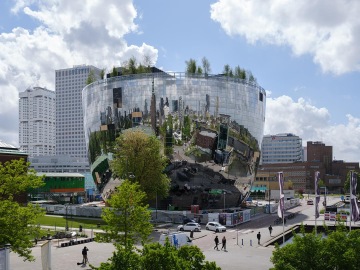
Martin: Yeah, I personally appreciate it, and I appreciate hearing you speak, because whenever I listen to you speak, particularly in an academic or conference setting, it's with visuals, right? We’re able to see the architecture that you are explaining. And for me and the listeners at home, you are verbalizing design and that’s a tough thing to do. We really appreciate you talking through that, and the conversation on provocation was interesting for me.
Nudity in Tainan was also nice. I wanted to add to that because the idea of being nude in public space or stripped down, we can’t be more real with each other, and I think that's a really important thing to know, when you are in the public bath, in Iceland, it’s just you and the water and everybody else. Everyone is sort of equal in that environment. These spaces have a way of democratizing the city. We really appreciate this conversation.
There are societies that see provocation as very negative and very biting and very dangerous, as such, so we have to find a culture where provocation is a help towards the future.
Winy: It’s like these 60s images of Superstudio or the Green Parties in Europe and the green posters they made. It has come to life after 60 years. I think it’s really great you make podcasts - it's a super good medium to listen for a longer time, while you’re driving in your car or in your bathtub, so I hope you do extend this and that your system multiplies, and find a reSITE 3.0, everywhere, so please go on.
Martin: Thank you so much. I think it’s the beginning of what’s coming next. I think the next time we talk, we can dig deeper into that question for what’s next.
Winy: Ok, we’ll do that, man.
That was Winy Maas, Co-founder of MVRDV and the Founder of The Why Factroy.
Design and the City was recorded at the WeWork offices in Prague, with the support of the Czech Ministry of Culture and Nano Energies. This podcast is produced by Alexandra Siebenthal, with support from Martin Barry, Radka Ondrackova, Elizabeth Mills and Elizabeth Novacek and edited by LittleBig Studio.
Cover image courtesy of BarbraVerbij
More from Design and the City
A New Generation of Architects with Chris Precht
Chris Precht’s aim to reconnect our lives to our food production by bringing it back into our cities and our minds can be found throughout his architecture. Listen as he discusses the importance of authenticity, creating spaces that activate our senses, and looking at our objective reality to solve the problems of our time.
Giving Design a Higher Purpose with Ravi Naidoo
Ravi Naidoo, the driving force behind Design Indaba, arguably the most influential design event in the world. The event takes place annually in Cape Town is only the tip of the iceberg. Listen as he pushes the boundaries of the purpose design holds with the simple question—what is design for? Photo courtesy of Design Indaba
Fighting Gentrification, Berlin-Style with Leona Lynen
A vast, unoccupied administration building in the heart of Berlin at Alexanderplatz - Haus der Statistik - has become a prototype for gentrification done right. Hear from Leona, a member of the cooperative, ZUsammenKUNFT, as she discusses how they are developing a mixed-use urban space oriented towards the common good. Photo courtesy of Nils Koenning
Designing on a Human Scale with Thomas Heatherwick
Thomas Heatherwick’s holistic approach brings a thoughtful dimension to architecture, design and urban spaces. Listen to the acclaimed designer along with ArchDaily editor, Christele Harrouk, as they explore how he approaches projects by considering them from a human scale.
Related Talks
Winy Maas on Why Dreaming About the Future of our Cities is Essential
Urban planner, architect, and co-founder of MVRDV interdisciplinary studio, Winy Mass, is reimagining cities and public spaces. He shares with us many of his innovative projects and his curiosity about how future cities will rethink functional space in the public domain.
Chris Precht on Connecting Architecture and Agriculture
Chris Precht, Studio Precht, believes that architecture has always been driven by fictional stories that subsequently have had a detrimental effect on the natural environment. He imagines a world where cities are designed to give back space to nature and reconnect our lives back to our sources of vitality.
Landscape is Everything Around You with Kathryn Gustafson
Kathryn Gustafson is a landscape architect and co-founded the landscape architecture firm Gustafson Porter + Bowman, based in London. Gustafson’s projects include Gardens of the Imagination in Terrasson, France, Westergasfabriek in Amsterdam, Diana, Princess of Wales Memorial Fountain in London.
Sou Fujimoto on Reinventing the Relationship Between Nature & Architecture
Sou Fujimoto, founder of Sou Fujimoto Architects in Tokyo, doesn’t see nature and the built environment as opposing forces, but seeks to integrate and learn from the environment as much as possible throughout the design process. Most notably, Fujimoto was selected to design the 2013 Serpentine Gallery Pavilion in London, and in 2019, as one of the 23 architects to reinvent Paris.
